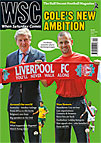 Sean Marihooks explains how large amounts of money has only thwarted the development of league football in the Gulf
Sean Marihooks explains how large amounts of money has only thwarted the development of league football in the Gulf
Dubai is famous as a hideaway for Premier League footballers and for running up the odd multibillion dollar debt. The UAE’s football league has barely registered internationally, however, until this summer when the top club Al Ahli signed Fabio Cannavaro and then appointed David O’Leary as coach. But the fanfare off the pitch may not be
followed by anything special on it.
In 1979, Liverpool used a rest period for a challenge match against the country’s oldest club, Al Nasr. A spectacular ceremony greeted their arrival on the pitch – fireworks exploded over a brand new stadium, while doves painted in the blue of Al Nasr and red of Liverpool were released. There was a problem, however – the paint weighed down the feathered symbols of peace and they were left hopping round the pitch being chased by ground staff. This was a metaphor for UAE football – good intentions that never quite get off the ground.
If O’Leary was to heed one piece of advice about his new job it would be to not pay more than a month’s rent in advance. In 2008, Al Wasl’s Czech coach, Miroslav Beranek, was sacked after two games. His successors barely had time to arrange family photos on their desks as the club went through four coaches in the 28-game season.
The league title tends to flip between clubs from the two biggest statelets, Abu Dhabi and Dubai, who currently have ten of the 12 top-level clubs. Attendances for most games in the UAE league are pitifully low – I have seen reigning champions watched by 250 – and any crowd that does happen to gather often has an ulterior motive. One game held up as a beacon of the sport’s marketability was last season’s top of the table fixture between Al Jazira and Al Wahda. The attendance of 25,000 included 15,000 who had allegedly been paid to chant and sing; rent-a-crowd is the only way to keep the turnstiles clicking.
A typical team is made up of local players propped up by three foreigners, mainly strikers, who can barely see the ball for the dollar signs in their eyes. The imports usually score a hatful of goals without breaking sweat, the local players stand in awe and the cycle repeats season after season. Good local products such as the 2003 World Youth Championship Golden Ball winner, Ismail Matar, never get the chance to develop in stronger leagues. Only two notable home-grown players have ever left the UAE and they went to Saudi Arabia and Qatar rather than Europe. The locals who want to see serious football watch the omnipresent Premier League and if rich enough, like Man City owner Sheikh Mansour, will buy their own slice of it.
Domestic football in the Gulf will not develop until club officials can see beyond the glitz temporarily provided by big names arriving from Europe for one final payday. Qatar tried it in the early 2000s with Gabriel Batistuta, Claudio Caniggia and the De Boer twins but the national side, padded out with swiftly naturalised South Americans, has yet to come close to World Cup qualification. The UAE did qualify for the finals in 1990 under legendary Brazilian coach Mário Zagallo who was then promptly dismissed. His successor, Carlos Alberto Parreira, presided over three limp defeats in the tournament and the country has not been near a World Cup since, unless you count the Dubai horse race of the same name.
The UAE is a master at becoming part of the football world at large. Emirates airline sponsors Arsenal’s stadium, Etihad Airways appear on the shirts of Sheikh Mansour’s Man City and Barcelona have a partnership with state telecom provider Etisalat. But they are not building sustainable foundations for their own clubs. The league itself should be run along the lines of the MLS or Australia’s A-League, with collective rights for commercial deals and TV coverage.
Broadcasting is currently split between Dubai and Abu Dhabi so two channels show the same game at the same time with two different panels and pitchside reporters. There have even been cases of TV companies trying to share facilities and realising they have different cable plugs and sockets. Meanwhile, clubs almost operate as two separate entities, with the first team coach having no knowledge of the youth system and the academy having no relationship with an ever changing senior staff. For all the money that is being spent, football in the UAE remains in serious need of major reform. Otherwise it will continue to hop around in a directionless way, like those spray-painted pigeons.
From WSC 283 September 2010